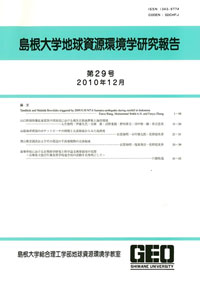島根大学総合理工学部地球資源環境学教室
ISSN:1343-9774

ダウンロード数 : ? 件
この文献の参照には次のURLをご利用ください : https://ir.lib.shimane-u.ac.jp/6083
島根大学地球資源環境学研究報告 20
2001-12-28 発行
火山泥流に埋もれたナチョラピテクス群:ケニア・リフト北部における1500万年前のアルメロの悲劇
Nasholapithecus buried under lahars 15 mllion years ago in the northern Kenya Rift:an event similar to the Armero Town tragedy in 1985,Colombia
澤田 順弘
中山 勝博
実吉 玄貴
山中 淳之
国松 豊
中務 真人
中野 良彦
辻川 寛
清水 大輔
高野 智
萩原 直道
マーティン ピックフォード
石田 英実
ファイル
内容記述(抄録等)
The Miocene strata in the Nachola area,northern Kenya have yielded many hominoid fossils which are important for the study of hominid evolution.The Joint Japan-Kenya team has conducted palaeontological excavations at Nachola since 1982 and has collected abundant fossil fauna,especially of Nacholapithecus,a hominoid of the Kenyapithecus group.
Nacholapithecus fossils were found at 15 sites in a thin horizon in the lowest part(15 Ma)of the Middle Miocene Aka Aiteputh Formation,scattered over an outcrop area of 13 km×3 km.The fossiliferous strata are covered by thick basalt lava flows.Clastic sedimentary rocks at representative fossil sites BG-K and BG-I are volcaniclastic and have been subdivided into at least 10 units,totaling about 13 m maximum thickness.Most of the clastic sediments are characteristically poorly sorted and are matrix supported with pyroclastic matrix and pumice(less than 2 cm in diameter).
They were mainly derived from a lahar,except for some units formed by flood or pyroclastic flow.Pyroclastic materials include volcanic glass,anorthoclase and aegirine augite derived from phonolitic trachyte.The Nacholapithecus fossils are well preserved,and many of the skeletal parts are in connection,especially at the site BG-K.
The hominoids seem to have been buried alive,similar to the situation that occurred on November13th,1985,at Amlero town,Colombia.Excavated fossils comprise many individuals of various age groups(infants to aged adults of both sexes)which may allow us to launch a new field of study,“palaeo-primate sociology”,which will throw light on the population structure of Macholapithecus groups.
Nacholapithecus fossils were found at 15 sites in a thin horizon in the lowest part(15 Ma)of the Middle Miocene Aka Aiteputh Formation,scattered over an outcrop area of 13 km×3 km.The fossiliferous strata are covered by thick basalt lava flows.Clastic sedimentary rocks at representative fossil sites BG-K and BG-I are volcaniclastic and have been subdivided into at least 10 units,totaling about 13 m maximum thickness.Most of the clastic sediments are characteristically poorly sorted and are matrix supported with pyroclastic matrix and pumice(less than 2 cm in diameter).
They were mainly derived from a lahar,except for some units formed by flood or pyroclastic flow.Pyroclastic materials include volcanic glass,anorthoclase and aegirine augite derived from phonolitic trachyte.The Nacholapithecus fossils are well preserved,and many of the skeletal parts are in connection,especially at the site BG-K.
The hominoids seem to have been buried alive,similar to the situation that occurred on November13th,1985,at Amlero town,Colombia.Excavated fossils comprise many individuals of various age groups(infants to aged adults of both sexes)which may allow us to launch a new field of study,“palaeo-primate sociology”,which will throw light on the population structure of Macholapithecus groups.
Other Article
